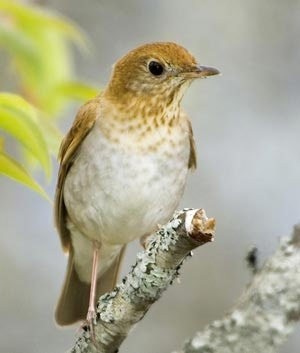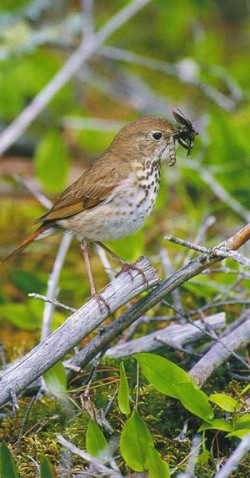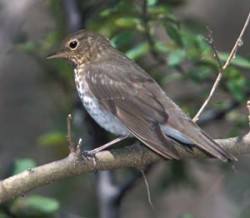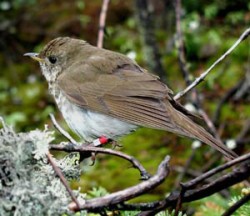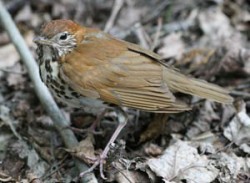Unless you are a fanatical birder, you may not be able to differentiate between the five species of brown thrushes found in northern New England and New York. All have wings and backs of varying shades of brown, and all have spotted breasts and whitish bellies. Similarly, all five forage generally on or near the ground. Their mystical songs, celebrated for their tone and beauty, attest to the birds’ elusiveness in the forest and may not lead the newcomer to positive identification. But habitat – knowing where you are in the landscape – may be the clue to knowing which species you are observing.
Thrushes are part of a large bird family that includes two other northeastern favorites, the American robin and the eastern bluebird. Six species of brown thrushes, also called spotted thrushes, breed in North America. The Northeast boasts five of these species, tand all can be found in a single day, if you’re up for a climb.
You begin your ascent by thrashing through a wet, shrubby swamp, where you may encounter the veery. Damp, deciduous woodlands below 2,000 feet, especially disturbed sites with a thick understory, provide the best habitat for the veery. A waterfront location – near a stream or swamp – makes for prime veery real estate. Listen for its mellifluous, downward-dropping song, akin to a cat walking down a piano.
Overlapping with the veery at low elevations, also below 2,000 feet, lives the wood thrush. It’s the largest of the spotted thrushes, has a reddish head, and sings a flutelike song. The wood thrush, as its name implies, inhabits more mature, shady woodlands than the veery; it prefers a closed canopy of tall deciduous trees, moist soil, and leaf litter. Within the forest, these birds need a lower shrub layer for nesting and foraging. The wood thrush tolerates forest edges and even some residential areas and therefore often falls prey to brown-headed cowbirds that lay eggs in the thrushes’ nests.
The hermit thrush occupies the broadest range of forest habitats, generally between 500 and 3,500 feet in elevation. Commonly found bobbing its tail up and down in dense conifers and mixed woods, the hermit thrush also inhabits interior edges around ponds or forest openings. Listen for it in coniferous or mixed woods containing some pine, hemlock, or spruce. As one of the most widely distributed forest songbirds on the continent, the hermit thrush may be best identified by its ethereal song with a long introductory note.
As you climb higher up, the Swainson’s thrush announces itself with an upwardly spiraling song. You will likely hear it in the spruce-fir zone – dense coniferous forest mixed occasionally with hardwoods. These areas, normally found between 2,000 and 4,000 feet, may contain mature trees, or disturbed patches, both of which the Swainson’s thrush will inhabit. High-elevation forests in the Northeast comprise the southern extent of its eastern range, mimicking its preference for boreal habitats. The species is common in the mountainous and northern parts of our region. If you catch a glimpse of this bird through the dense conifers, you may see the characteristic buffy ring around its eye.
Ascending to the summit of one of our tallest mountains, you will be lucky to encounter a Bicknell’s thrush – the only songbird endemic to the Northeast. While the Swainson’s thrush inhabits more mature forest stands, Bicknell’s thrush occupies stunted and regenerating fir-spruce communities found only on our highest peaks, typically between 3,500 feet and treeline. These subalpine habitats are scattered in small patches across the landscape, leaving populations of Bicknell’s thrush relatively low. Acid precipitation and climate change threaten to degrade more of the Bicknell’s precious habitat.
Once atop the mountain, you’ll be able to look out over the forest and identify the various brown thrush habitats. While there is overlap, these five closely related birds have nonetheless found a way of separating themselves into different niches to avoid competing with one another. You can avoid a lot of the confusion in identification if you pay as close attention to the habitat as they do.


